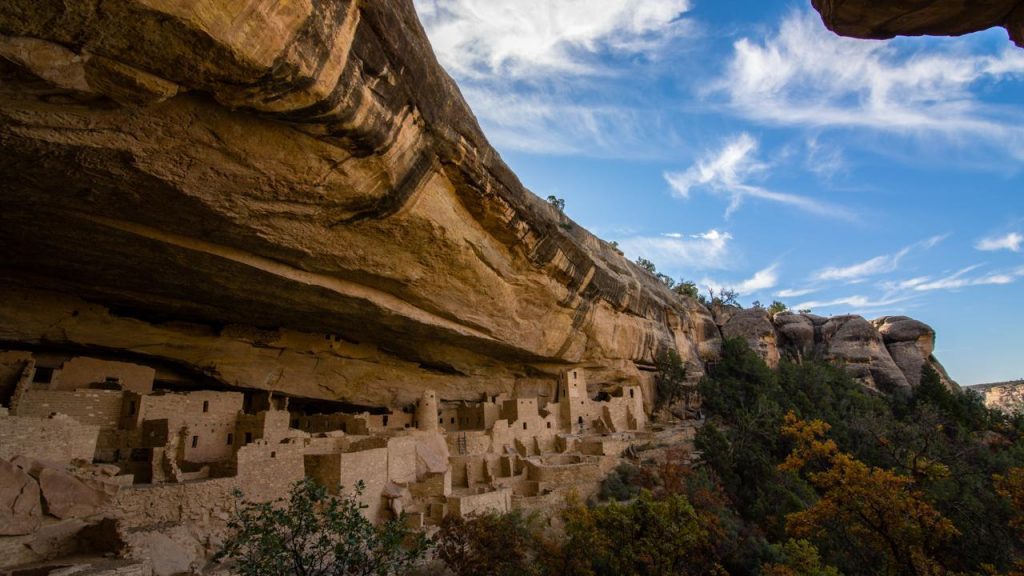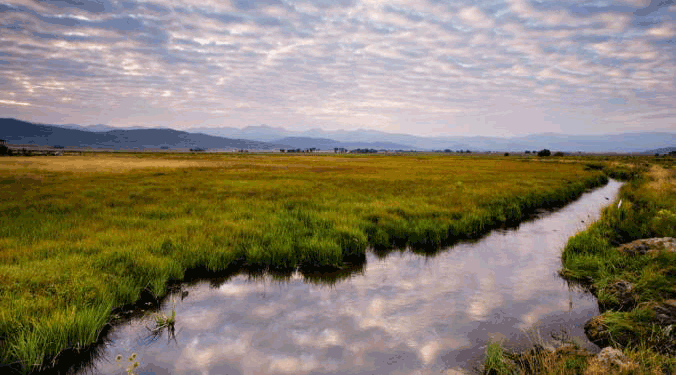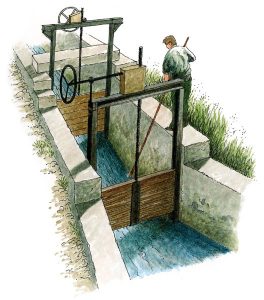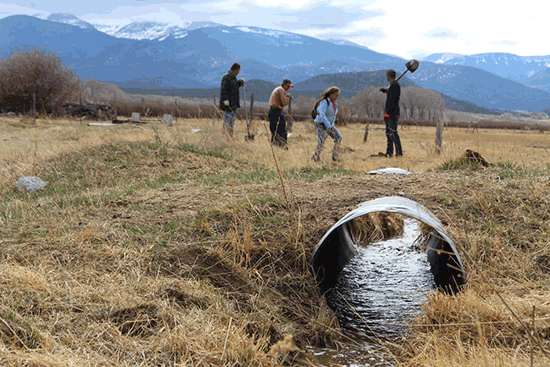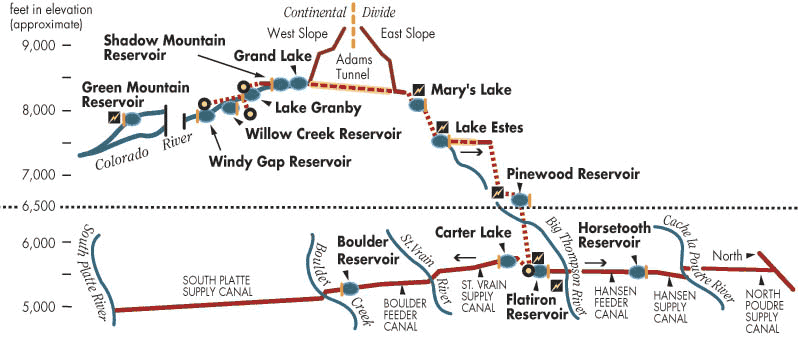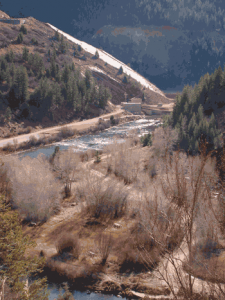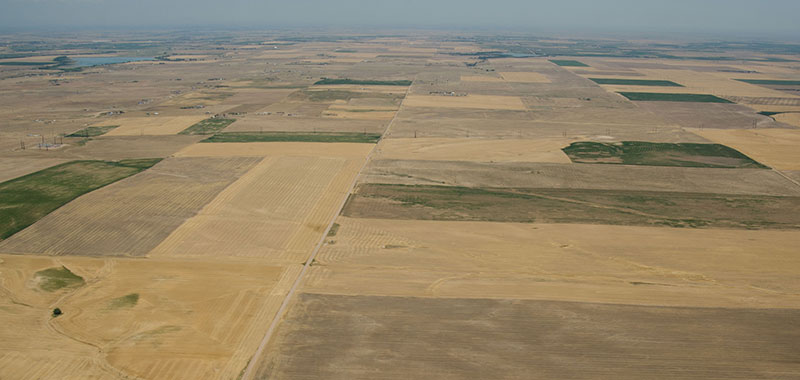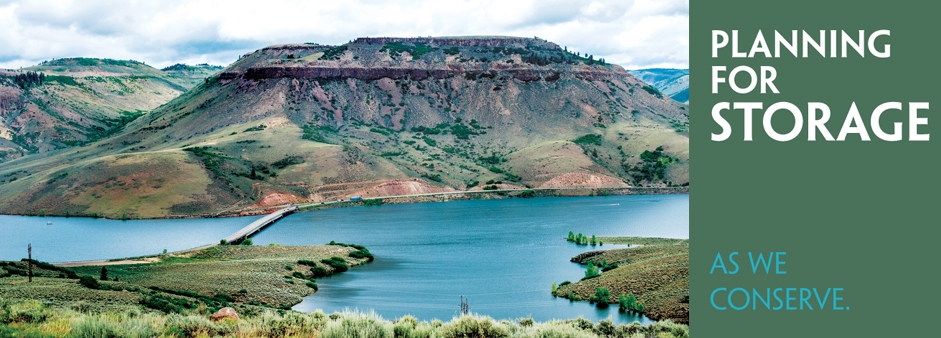The history of water in Colorado is a story of natural history, geography, people, place, politics, and climate—and the myriad ways in which these different facets interact and overlap. Much of the state’s water history has been shaped by population growth. In particular, a tenfold increase in residents from 1900 to 2010 (U.S. Census Bureau, n.d.) was paralleled by a similar increase in competition and demand for the water in Colorado’s nine major watersheds and four major aquifers.
Water History
Long before to the arrival of settlers, the first people settled in Mesa Verde in approximately 550 AD and resided in the region until the late 13th century (U.S. Bureau of Reclamation [USBR], n.d.). More than 20 examples of prehistoric water basins with storage capacities of at least 10,000-25,000 gallons are known to exist in this region (Wilshusen et al., 1997). It is believed that the Pueblo peoples primarily stored domestic water in these basins, representing early experiments with large-scale water conservation (Wilshusen et al., 1997). The construction of these basins also suggests that as Mesa Verde communities became increasingly complex and permanently settled, they had to find ways to buffer themselves against aridity and environmental unpredictability; their survival and quality of life depended on their ability to cooperatively maintain these water storage features (Wilshusen et al., 1997). The Pueblo inhabitants also constructed low stone masonry check-dams across intermittent drainages to form farming terraces and to catch and store water for irrigation (Rohn, 1963).
Considered as a whole, these water capturing and storage features indicate that water was one of the Pueblo peoples’ more valuable resources, and that much energy was dedicated to assuring its adequate supply. Substantial domestic water storage, such as Mummy Lake, allowed a large concentration of people to inhabit the immediately surrounding region. Terracing and drainages allowed for irrigation and the production of tillable soil for agriculture (Rohn, 1963; Stiger, 1979).
In 1852, Hispanic settlers dug what is now known as the People’s Ditch—the oldest irrigation system in continuous use in the state. It is located at 8,000 feet in elevation and is supplied with water by Culebra Creek (Library of Congress, n.d.). This region was part of Mexico until 1848, but the water right to the ditch was eventually allotted under Colorado’s doctrine of prior appropriation (which did not officially arrive until 1876) and given an adjudication date of 1852 to indicate priority, making it the earliest recognized water right in Colorado.
This water right was not allotted under Colorado’s doctrine of prior appropriation, but under traditional Hispanic water laws and irrigation practices known as acequias. Executed by the settlers who were sent to the region to develop land grants conferred by Mexico, acequias were water distribution systems that established rules for water sharing in times of scarcity and enforced a commitment to community-based water governance. People’s Ditch was followed by the construction of six more acequias in the Culebra watershed by the end of 1855 (Hicks & Peña, 2004).
Colorado Water Rights History
In 1876, the Colorado Constitution instituted the Doctrine of Prior Appropriation, which decreed the standard that to obtain a water right, water must be put to a beneficial use. Such rights may be bought, sold, inherited, relocated, or altered in its use, as long as the change did not injure or impose upon other water rights. The Constitution also ranked water uses in the following order: domestic, agricultural, industrial. In 1957, tributary groundwater became subject to this doctrine under the Ground Water Management Act (State of Colorado, n.d.b).
The Colorado’s Office of the State Engineer was established in 1881, making Colorado the first state to have a dedicated water management office and the first with public officials to administer private water use (Comstock, 1911). Shortly thereafter, the Colorado Supreme Court heard two cases foundational to contemporary Colorado water law: Fuller v. Swan River Placer Mining Company (1888) and was Strickler v. City of Colorado Springs (1891) (McIntyre, 2017). The Fuller case granted the right to change a water right’s place of diversion and place of use. The Strickler case declared water rights to be property protected by the US Constitution. Accordingly, Prior Appropriation as established by the Colorado Constitution henceforth applied only to new water rights (McIntyre, 2017).
To learn more about Colorado Water Rights, visit our Water Rights section.
History of Trans-Basin Diversions
Early Diversions
Colorado’s earliest diversions were projects of necessity, constructed in times of water shortage. In 1882, the Cameron Pass Ditch created a diversion of Michigan Creek in the North Platte Basin to the Cache la Poudre watershed in the South Platte Basin; it was the first project to cross a significant river basin boundary. In 1894, the Grand River Ditch became the first trans-basin diversion from the Colorado River, delivering water from a number of its tributaries to farmlands along the Poudre River. Little was available in the way of governmental intervention or leadership for the construction of these early diversions: only water and property rights—not yet a rare commodity in Colorado—needed to be obtained in order to break ground on trans-basin diversions (Water Education Colorado [WEco], 2014).
Yet as population growth and agricultural demand for water along the Front Range expanded, the state began commissioning studies to examine the feasibility of larger diversions for transporting Western Slope water to the eastern plains (WEco, 2014). This movement gained momentum in the early 1930s, when Eastern Slope newspaper editors, politicians, and waters users organized into what would become the Northern Colorado Water Conservancy District (Schulte, 2004).
Twin Lakes Project
Conceptualized in the 1920s by the privately owned Twin Lakes Reservoir and Canal Company, the Twin Lakes project aimed to transfer 20,000 acre-feet of water annually from the Roaring Fork watershed to the headwaters of the Arkansas River via a tunnel under the Continental Divide. The Western Colorado Protective Association and Bureau of Land Reclamation agreed to make the project a reality in 1933, and construction was completed in 1935. Today, the Twin Lakes diversion supplies about 38,000 acre-feet of water annually to the Arkansas River and Colorado Canal for users near Fowler, Ordway, and Sugar City (WEco, 2014).
Colorado-Big Thompson Project
In 1937, the state formalized such water conservancy districts, water conservation districts, and the Colorado Water Conservation Board in response to the Northern Colorado Water Conservancy District proposal for an immense diversion project to take water from the headwaters of the Colorado River and bring 300,000 acre-feet of water annually to the Eastern Slope—the Colorado-Big Thompson (C-BT) Project. That same year, Congress approved Senate Document 80, authorizing construction to begin (Schulte, 2004). Construction lasted from 1938 to 1957, resulting in the largest trans-mountain diversion project in the state. The original aim for the project was to obtain more water for agricultural uses, but that water has slowly been purchased by and transferred to municipalities over the decades (Northern Water, n.d.a). Today, the Northern Colorado Water Conservancy District administers the delivery of C-BT water to cities such as Fort Collins, Boulder, Greeley, Longmont, and Loveland. It provides supplemental water to 29 cities and towns, more than 100 ditch and reservoir companies, and 640,000 acres of irrigated farmland. The project consists of four hydroelectric power plants, 12 reservoirs, 35 miles of tunnels, 95 miles of canals, and 700 miles of transmission lines. Approximately 230,000 acre-feet of water are delivered annually through the C-BT system (Northern Water, n.d.a).
Fryingpan-Arkansas Project
In 1958, water users in the Arkansas Basin proposed a new Southeastern Colorado Water Conservation District—a move they hoped would reinvigorate legislative support for the Fryingpan-Arkansas diversion after nearly three decades of delays and disputes driven by opposition to the project from the Western Slope. By 1959, the years of political lobbying by Arkansas Basin stakeholders finally paid off. Construction began with Ruedi Reservoir, which would provide 102,000 acre-feet of compensatory and replacement water for West Slope users annually, in 1964. The diversion tunnel soon followed, and was under construction from 1965 to 1971. Today, the Fryingpan-Arkansas diversion delivers irrigation water for 265,000 acres of agricultural lands and supplies municipalities in the Colorado Springs area (WEco, 2014).
To learn more about Colorado’s surface water resources, visit the Surface Water Resources section.
Water Use Over Time
Water use in Colorado has changed over time as the state has shifted from a primarily rural, agricultural landscape to one that is increasingly urban and suburban. Agriculture is still a major industry, commanding more than $40 billion annually, and remains Colorado’s dominant water user. Irrigated farmland accounts for less than 10 percent of the state’s privately owned land area but uses 86 percent of its total water diversions (Zaffos, 2015). While it remains an economic and cultural driver, agricultural labor is declining. Volatile commodity prices, farm consolidation, the rising production costs, and declining numbers of young farmers all contribute to this trend.
At the same time, rising water demands from Colorado’s rapidly growing cities, its energy developers, and its recreational and environmental needs have been exacerbated by the difficulty in permitting new water storage projects. In response, municipalities are increasingly pursuing acquisitions of senior agricultural water rights from farmers willing to sell—a process known informally as “buy and dry.” During the period from 1997 to 2012, this strategy was the primary contributor to the loss of at least 850,000 acres (about 25 percent) of the state’s irrigated farmland (Zaffos, 2015). According to the Colorado State Demography Office (2018), the trend of increasing demand will continue: the state could see 6 million residents by 2020 and 9 million by 2050, with a corresponding municipal water supply gap of up to 500,000 acre-feet by 2050 unless the state’s water suppliers and users can all work together to address the shortfall.
Colorado’s water scarcity is further compounded by recurring drought conditions, which are now intensified by rising temperatures associated with climate change. Such conditions reduce streamflows and contribute to groundwater declines, further diminishing the water available for farmland irrigation. In response, many Colorado farmers are adapting their practices to use less water—planting rotational and more drought-resistant crops, adopting innovative irrigation techniques, and relying on strip-tilling or no-till practices (Zaffos, 2015).
To learn more about water uses, visit our Water Uses section.
The Future of Colorado Water
Since 2005, Colorado’s nine Basin Roundtables, the Interbasin Compact Committee, the Colorado Water Conservation Board, and stakeholders statewide have collaborated to determine how to implement water supply solutions to meet future needs. These groups have also balanced these needs against support for healthy watersheds and the environment; robust recreation and tourism economies; vibrant and sustainable cities; and viable and productive agriculture.
Since 2005, Colorado’s nine Basin Roundtables, the Interbasin Compact Committee, the Colorado Water Conservation Board, and stakeholders statewide have collaborated to determine how to implement water supply solutions to meet future needs. These groups have also balanced these needs against support for healthy watersheds and the environment; robust recreation and tourism economies; vibrant and sustainable cities; and viable and productive agriculture.
Following severe droughts in 2002 and 2003, the Water Conservation Board has also been leading the most comprehensive analysis of state water supplies ever undertaken through the Statewide Water Supply Initiative (State of Colorado, n.d.a), and a new era in public works is beginning. In 2017, two Army Corps of Engineers dam projects were greenlighted—the first in 25 years. First, Denver Water announced a $380 million expansion of Gross Reservoir, which will increase its storage by 18,000 acre-feet. Second, Northern Water was approved for the $425 million Windy Gap Firming Project in Berthoud, which will capture water from the Fraser River and deliver it to a brand new 90,000 acre-foot reservoir in Chimney Hollow (Lotus, 2017).
The concept of One Water is another force behind Colorado’s shifting water landscape. One Water recognizes the need to prioritize the best use of each type of water flow through infrastructure and communities. Focused on conservation, reuse and natural hydrology, integrated water management is the core principle of One Water. It advocates for collaboration and cooperation of utilities, customers, planners, designers and engineers; it is a vision for water centered on resiliency, water security, public health, and sustainable cities (U.S. Green Building Council [USGBC], 2017).
To learn more about water conservation, visit our Conservation section.
Colorado Encyclopedia. (n.d.). Water in Colorado. Articles.
Colorado State University Libraries. (n.d.). Colorado Water History: A guide to finding and using historical information about water in Colorado and beyond. Colorado Water History.
Grigg, N. (2004). Colorado’s Water: Science and Management, History and Politics. Paper presented at Water Resources and Environment History Sessions at the Environmental and Water Reources Institute Annual Meeting, 2004. Salt Lake City, UT.
Rettig, P. (2012). Colorado’s Water History. Prezi.
Water Education Colorado [WEco]. (2014a). Citizen’s Guide to Colorado Water Heritage. ISSUU.
—–. (2014b). Citizen’s Guide to Colorado’s Transbasin Diversions. ISSUU.
Water Information Program. (n.d.). History of Colorado Water. Resources.
Ben Earwicker Garrison Photography. (2008). Denver, Colorado. [IMAGE]. Freeimages.com.
Colorado State Demography Office. (2018). Population Totals for Colorado and Sub-State Regions: Population Forecasts. Colorado Department of Local Affairs.
Colorado State University Extension. (n.d.). Drought in Colorado. [IMAGE]. Drought Frequently Asked Questions.
Comstock, C. W. (1911). Fifteenth Biennial Report of the State Engineer. Denver, CO: The Smith-Brooks Printing Co, State Printers.
Dykinga, J. (2010). San Luis Valley, Colorado. [IMAGE].
González-Adalid Cabezas, I. (2005). Historic Acequias Illustration. [IMAGE]. In Vera Nicolás, P., Murcia and Water: History of a Passion (Chapter 6: The acequias and the dead waters). Joint Regional Assembly Committee of Murcia and Royal Academy Alfonso X el Sabio de Murcia.
Hicks, G. & Peña, G. (2004). Sin agua no hay vida: Colorado’s Acequias—A Water Democracy. In Citizen’s Guide to Colorado’s Water Heritage. Colorado Foundation for Water Education.
Library of Congress. (.n.d). San Luis Peoples’ Ditch, San Luis, Costilla County, CO. Historic American Engineering Record.
Lotus, J. (2017, November 22). Colorado River Journey: The Past And Future Of Water Use. Patch.
McIntyre, William C., and David C. Mays. (2017). Roles of the Water Court and the State Engineer for Water Administration in Colorado. Water Policy, 19(5), 837–850.
National Park Service. (n.d.). Park Air Profiles – Mesa Verde National Park. [IMAGE]. Series: Park Air Profiles.
—–. (2008). Effects of the Grand Ditch. [IMAGE]. Rocky Mountain National Park.
—–. (2018). Preserving Pueblo Heritage. Mesa Verde.
Northern Water. (n.d.a). Colorado-Big Thompson Project. Water Projects.
—–. (n.d.b). Colorado-Big Thompson Profile Map. [IMAGE]. Water Projects: How C-BT Works.
—–. (n.d.c). C-BT Construction. [IMAGE]. C-BT History.
Rohn, Arthur H. (1963). Prehistoric Soil and Water Conservation on Chapin Mesa, Southwestern Colorado. American Antiquity, 28(4) 441–455.
Runyon, L. (2018). Acequias in southern Colorado. [IMAGE]. KUNC.
Schulte, S. (2004). Building the Vision: Taylor, Aspinall, and Water for Western Colorado. The Citizens Guide to Colorado’s Water Heritage. Colorado Foundation for Water Education.
State of Colorado. (n.d.a). About Colorado’s Water Plan. The Plan.
—–. (n.d.b). Early Water Law in Colorado. Water Records.
—–. (n.d.c). Planning for Storage as We Conserve. [IMAGE]. Colorado Water Plan.
Stiger, Mark A. (1979). Mesa Verde Subsistence Patterns from Basketmaker to Pueblo III. Kiva, 44(2-3), 133–144.
U.S. Bureau of Reclamation [USBR]. (n.d.). Ruedi Reservoir. [IMAGE]. Great Plains Region.
U.S. Census Bureau. (n.d.). Urban/Rural Population by State 1900 – 2010. Census Data for Colorado (2010).
U.S. Green Building Council [USGBC]. (2017). One Water: The Future of Water in Colorado. Rocky Mountain Green 2017.
Water Education Colorado [WEco]. (2014). Citizen’s Guide to Colorado’s Transbasin Diversions. ISSUU.
Wilshusen, Richard H., et al. (1997). Prehistoric Reservoirs and Water Basins in the Mesa Verde Region: Intensification of Water Collection Strategies during the Great Pueblo Period. American Antiquity, 62(4), 664–681.
Zaffos, J. (2015). Managing Agriculture and Water Scarcity in Colorado (and Beyond). Denver, CO: Colorado Foundation for Water Education and CoBank.

